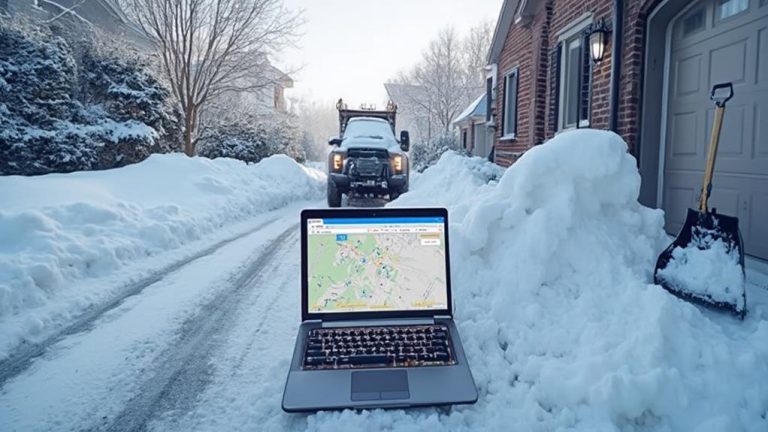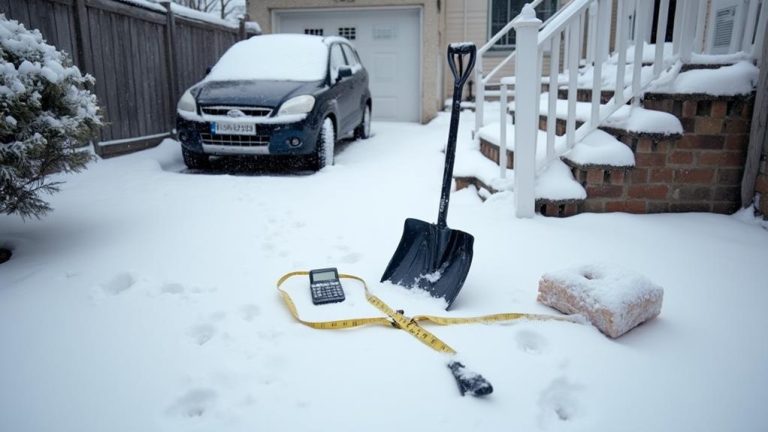Winter weather forecasting provides essential information to help you navigate the challenges of cold seasons. By utilizing advanced technology and meteorological expertise, forecasters can predict snowfall, ice accumulation, and wind chill factors with increasing accuracy. This knowledge allows you to prepare for potential hazards, such as slippery roads, reduced visibility, and dangerous wind chills. You can make informed decisions about travel, school closures, and outdoor activities, while also taking necessary precautions to protect your property and loved ones. Understanding winter weather advisories and their criteria enables you to interpret forecasts effectively and respond appropriately to changing conditions. Exploring the intricacies of winter weather forecasting can further enhance your preparedness and safety during the colder months.
Snow Plowing Highlights
- Winter weather forecasting uses advanced technology to predict snow, ice, and extreme cold conditions.
- Meteorologists analyze atmospheric data, satellite imagery, and computer models to create accurate forecasts.
- Forecasts typically include expected precipitation types, accumulation amounts, temperatures, and wind chill factors.
- Winter weather advisories communicate potential hazards, affected areas, and duration to help people prepare.
- Accurate forecasts enable better travel planning, resource allocation, and emergency preparedness for individuals and organizations.
Definition of Winter Weather Advisory

Snow Plow Solutions offers thorough winter weather management services to help businesses and homeowners navigate the challenges of Winter Weather Advisories. Our expert team utilizes advanced forecasting technology to monitor weather conditions and provide timely snow removal and ice management services.
We deploy a fleet of state-of-the-art snow plows, salt spreaders, and de-icing equipment to secure safe and accessible parking lots, driveways, and walkways. Our ice control services are designed to reduce slip-and-fall risks, keeping your property safe during harsh winter conditions. Additionally, we provide customized snow management plans tailored to the specific needs of each business.
Advisory Criteria and Thresholds
A Winter Weather Advisory is a paramount alert issued by the National Weather Service when specific weather conditions are expected to cause significant inconvenience and hazards. The criteria and thresholds for issuing these advisories vary depending on your location and the type of winter weather event anticipated.
You’ll find that in most areas, an advisory is issued when snowfall is expected to reach 3 to 5 inches within 12 hours, or when a combination of snow, sleet, or freezing rain is forecasted to create hazardous conditions.
For freezing rain, the threshold is typically around 0.25 inches of ice accumulation. Wind chill advisories are issued when the wind chill index is expected to fall between -15°F and -24°F for at least three hours. It’s imperative to understand that these thresholds may be lower in southern regions where winter weather is less common, as residents and infrastructure aren’t as accustomed to such conditions.
Potential Hazards Communicated
Winter Weather Advisories serve as essential communications about potential hazards during inclement conditions. When you receive one, you’ll be informed about a variety of risks that could affect your safety and daily activities. These advisories typically highlight hazards such as light to moderate snow accumulation, sleet, or freezing rain that may cause slippery road conditions and reduced visibility.
You’ll also be alerted to potential issues like black ice formation on roadways and sidewalks, which can pose significant dangers to both drivers and pedestrians. The advisories often include information about wind chill factors, which can lead to rapid heat loss and increase the risk of hypothermia or frostbite if you’re exposed to the elements for prolonged periods.
Additionally, you’ll be notified about the possibility of downed power lines or tree limbs due to ice accumulation or strong winds. These communications may also mention the potential for travel delays, school closures, or other disruptions to your daily routine. By providing you with this detailed information, Winter Weather Advisories allow you to make informed decisions about your activities and take necessary precautions to safeguard your safety during challenging winter conditions.
Duration and Affected Areas
Generally, Winter Weather Advisories are issued for specific geographic areas and cover a defined time period. These advisories typically encompass regions that are expected to experience winter weather conditions that may pose inconveniences or hazards to daily activities.
The duration of an advisory can range from a few hours to several days, depending on the severity and persistence of the forecasted weather system. Meteorologists analyze various atmospheric factors, including temperature, precipitation patterns, and wind speeds, to determine the extent and duration of the affected areas.
When you’re in an area under a Winter Weather Advisory, it’s vital to stay informed about the expected conditions and their potential impact on your community. Consider the following:
- Your neighborhood may face challenging travel conditions
- Local businesses and services might’ve reduced hours or closures
- School schedules could be disrupted, affecting your family’s routine
- Power outages may occur, requiring preparation for extended periods without electricity
- Outdoor activities and events might be postponed or canceled
Understanding the duration and affected areas of a Winter Weather Advisory allows you to make informed decisions about your daily plans, travel arrangements, and necessary precautions. By staying vigilant and prepared, you’ll be better equipped to navigate the challenges posed by winter weather events in your region.
Benefits
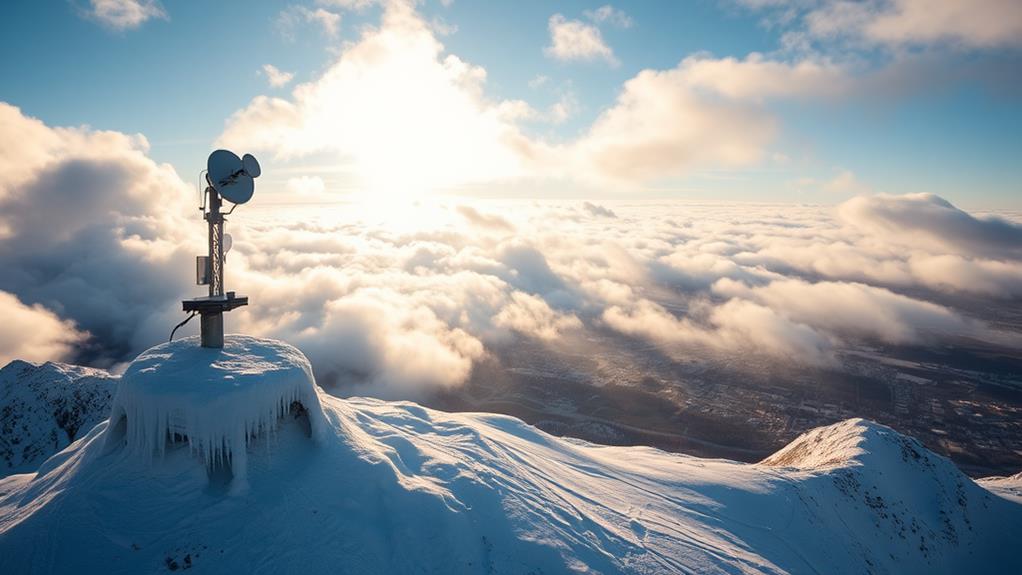
Winter weather forecasting offers numerous benefits that can considerably impact your daily life and decision-making processes. You’ll find that improved safety measures and efficient resource allocation are at the forefront of these advantages, allowing communities and individuals to better prepare for and respond to harsh winter conditions.
For instance, businesses and homeowners can maintain clear and safe properties by anticipating snowfall and scheduling timely snow removal services. Additionally, the ability to plan travel more effectively and make informed agricultural decisions based on accurate forecasts can lead to increased productivity and reduced risks associated with severe winter weather.
Improved Safety Measures
Accurate winter weather forecasting leads to vastly improved safety measures, benefiting both individuals and communities. When you’re equipped with reliable predictions, you can take proactive steps to protect yourself, your loved ones, and your property from winter’s harsh conditions.
Local authorities and emergency services can strategically allocate resources, ensuring that roads are cleared, power lines are maintained, and essential services remain operational during severe weather events.
With advanced warning, you’ll have the opportunity to:
- Stock up on necessary supplies, avoiding last-minute panic
- Prepare your vehicle with winter tires and emergency kits
- Secure outdoor items that could become hazards in high winds
- Plan alternative routes for essential travel
- Arrange for vulnerable neighbors to receive assistance
Snow removal services can be more efficiently deployed, utilizing a combination of plows, salt spreaders, and de-icing agents to maintain safe road conditions. Public transportation systems can adjust schedules and routes to accommodate weather-related challenges, minimizing disruptions to your daily commute.
Additionally, airports can proactively manage flight schedules, reducing the likelihood of passengers becoming stranded due to unexpected closures or delays. By leveraging accurate forecasts, you’re empowered to make informed decisions that contribute to a safer winter season for everyone in your community.
Efficient Resource Allocation
By harnessing the power of precise winter weather forecasts, you’ll be able to allocate resources more efficiently, saving both time and money. You can anticipate when and where to deploy your snow removal equipment, ensuring that you’re prepared for incoming storms without unnecessarily mobilizing your fleet. This proactive approach allows you to schedule your workforce more effectively, reducing overtime costs and minimizing employee fatigue.
With accurate forecasts, you can optimize your salt and de-icing material usage, applying them only when and where they’re needed most. This targeted application not only conserves resources but also minimizes environmental impact. You’ll be able to prioritize high-traffic areas and critical infrastructure, ensuring that essential routes remain clear and safe for your community. Additionally, you can coordinate with other departments or agencies to share resources and avoid duplication of efforts.
Better Travel Planning
For travelers and commuters, reliable winter weather forecasts offer a game-changing advantage in planning trips and daily routines. By leveraging accurate predictions, you’ll be able to make informed decisions about your travel arrangements, potentially avoiding hazardous conditions and minimizing disruptions to your schedule.
Advanced forecasting techniques allow you to anticipate road closures, flight delays, and public transportation interruptions, enabling you to adjust your plans accordingly and explore alternative routes or modes of transport.
With precise winter weather forecasts at your fingertips, you can:
- Confidently schedule important meetings or events
- Pack appropriate clothing and gear for your journey
- Prepare your vehicle for icy or snowy conditions
- Plan extra travel time to account for potential delays
- Make informed decisions about canceling or postponing trips
Agricultural Decision-Making Support
Leveraging reliable winter weather forecasts, farmers and agricultural professionals can make essential decisions that considerably impact their operations and yields. You’ll find that accurate predictions of temperature, precipitation, and frost events allow you to plan pivotal activities such as planting, harvesting, and crop protection measures. By utilizing these forecasts, you’re able to optimize irrigation schedules, mitigate frost damage risks, and determine the best times for applying fertilizers or pesticides.
Moreover, winter weather forecasts enable you to prepare for potential challenges, such as heavy snowfall or extreme cold, which might affect livestock management or greenhouse operations. You can make informed decisions about feed storage, shelter preparations, and energy consumption for heated structures. These forecasts also help you anticipate potential disruptions to transportation and supply chains, allowing you to adjust your logistics and distribution plans accordingly.
Snow Plowing Company Near you
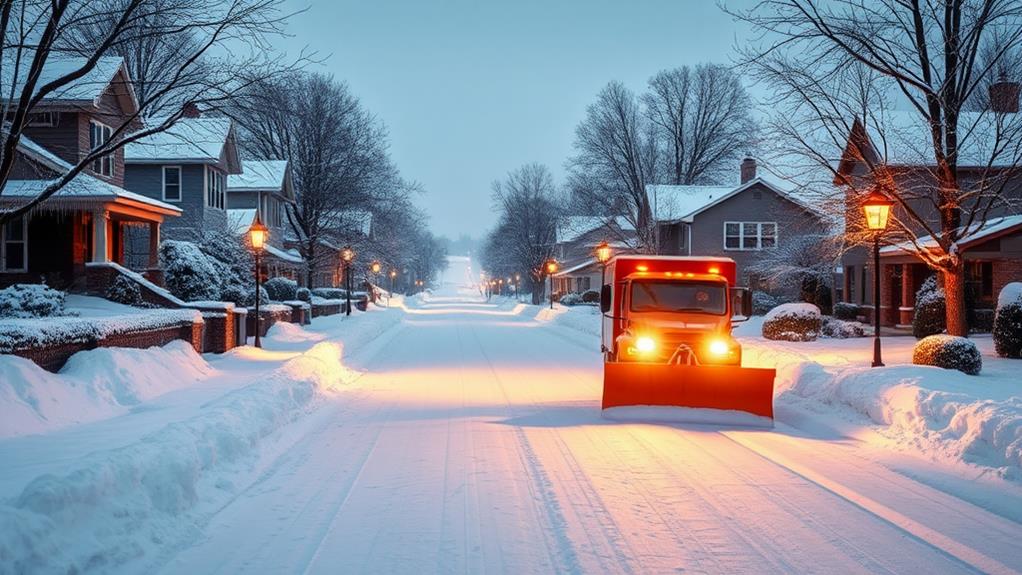
Snow Plow Solutions offers detailed commercial snow plowing and removal services to keep your business operational during winter weather. Our experienced team uses state-of-the-art equipment to efficiently clear snow and ice from parking lots, walkways, and entrances, ensuring safe access for employees and customers.
Rooted in the experiences of long-time Minnesota residents, we recognize the need for reliable and adaptable snow management. We provide customized snow management plans tailored to your specific property needs, including pre-treatment services, 24/7 monitoring, and prompt response times.
Connect With A Team Member Today!
Don’t let winter weather catch you off guard! Our team specializes in professional snow plowing and removal services and is ready to assist you.
Winter Storm Emergency Preparedness
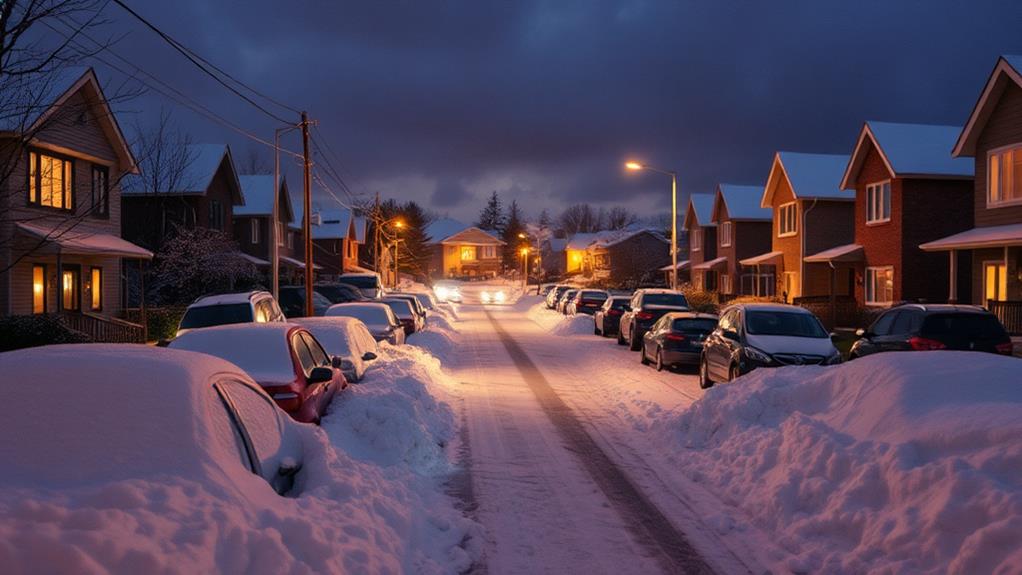
As you prepare for potential winter storm emergencies, it’s indispensable to assemble an emergency supply kit, develop a thorough communication plan, and establish safe shelter strategies. Your emergency supply kit should include essential items such as non-perishable food, water, medications, first-aid supplies, and warm clothing, ensuring you’re equipped to weather extended periods without power or access to resources. Developing a communication plan that includes contact information for family members, emergency services, and designated out-of-area contacts will help you stay connected and informed during a crisis. To enhance your preparedness, consider the following table of key elements:
| Emergency Kit Essentials | Communication Plan | Shelter Strategies |
|---|---|---|
| Non-perishable food | Family contacts | Insulate windows |
| Bottled water | Emergency services | Seal drafts |
| Medications | Out-of-area contact | Designate safe room |
| First-aid supplies | Meeting locations | Stock blankets |
Emergency Supply Kit Essentials
During winter storms, having a well-stocked emergency supply kit can mean the difference between comfort and crisis. As you prepare for the harsh winter months, it’s vital to assemble an extensive kit that addresses all potential needs during an extended period of isolation or power outage. Your kit should include non-perishable food items, bottled water, essential medications, first-aid supplies, and warm clothing. Additionally, consider including battery-powered or hand-crank devices such as flashlights, radios, and phone chargers to maintain communication and stay informed about weather updates.
To certify you’re fully prepared, incorporate these essential items into your emergency kit:
- Thermal blankets and sleeping bags for warmth
- Multi-tool and duct tape for emergency repairs
- Waterproof matches and fire starters
- Personal hygiene items and sanitation supplies
- Important documents in a waterproof container
Communication Plan Development
Developing a robust communication plan is an essential step in winter storm emergency preparedness. You’ll want to ascertain that every member of your household or organization knows how to stay in touch during severe weather events. Start by creating a contact list with phone numbers, email addresses, and social media handles for all relevant individuals, including family members, neighbors, and local emergency services. It’s vital to designate an out-of-area contact who can serve as a central point of communication if local lines become overwhelmed.
Next, familiarize yourself with various communication methods, such as text messaging, social media platforms, and emergency alert systems. Many communities offer opt-in services for weather alerts and emergency notifications, so be sure to sign up for these valuable resources. Additionally, consider investing in a battery-powered or hand-crank radio to receive updates if power outages occur.
Establish predetermined meeting points, both near your home and in a nearby town, in case evacuation becomes necessary. Regularly review and update your communication plan, ensuring that all contact information remains current and that everyone understands their role in staying connected during winter emergencies.
Safe Shelter Strategies
Safe shelter strategies form the backbone of winter storm survival. When severe winter weather strikes, you’ll need a secure location to wait out the storm. Your home, if properly prepared, can serve as your primary shelter. Guarantee that you’ve insulated your walls and attic, installed storm windows or covered windows with plastic, and sealed any air leaks around doors and windows.
If you’re caught away from home during a winter storm, identify public buildings such as libraries, shopping malls, or community centers that can serve as temporary shelters.
In your shelter, whether at home or elsewhere, you should have the following essential items:
- Warm blankets and extra clothing to prevent hypothermia
- Non-perishable food and water for at least three days
- Battery-powered or hand-crank radio for emergency updates
- First aid kit and necessary medications
- Flashlights and extra batteries for potential power outages
Frequently Asked Questions
How Accurate Are Long-Term Winter Weather Forecasts?
You’re right to be curious about long-term forecasts! They’re not always spot-on, but they can give you a general idea. Remember, weather’s tricky, so it’s best to stay flexible and check for updates closer to your plans.
What Factors Influence the Formation of Lake-Effect Snow?
You’ll find lake-effect snow forms when cold air moves over warmer lakes. It’s influenced by temperature differences, wind direction, and lake size. You’re in for a snowy treat if you’re near a large lake in winter!
How Do Meteorologists Determine the Difference Between Sleet and Freezing Rain?
You’ll notice meteorologists look at temperature layers in the atmosphere. They’ll check if there’s a warm layer aloft. If it’s thin, you’ll get sleet. If it’s thick, you’ll see freezing rain. It’s all about those layers!
Can Winter Weather Patterns Be Affected by Climate Change?
Yes, climate change can affect winter weather patterns. You’ll notice shifts in snowfall, temperature extremes, and storm intensity. We’re all experiencing these changes together, so it’s important to stay informed and support each other through these alterations.
What Technology Is Used to Predict Winter Storm Intensity and Path?
You’ll find that weather satellites, Doppler radar, and supercomputers are your go-to tools for predicting winter storms. They’ll help you track intensity and path, keeping you and your community prepared for whatever Mother Nature throws your way.


